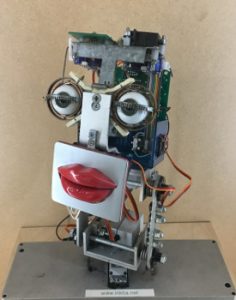Can robots make us into better presenters?

Robots are already capable of a great number of things. But for them to give a presentation? Nah.
That is what I thought. And possibly, so did you. Until I attended the robot expo at the Science Museum in London. Robots could be taking your spot on stage sooner than you think.
Should you be worried? Perhaps, yes.
Robots as you knew them, are no longer
What do you imagine when you hear the word ‘robot’? A tin structure, shuffling around absent-mindedly, with a constant beeping to go along? Then hurry on over to the robot expo at the London Science Museum. You will get an overview through the ages of the first mechanical wonder objects – such as moving holy statues – all the way over to the latest wave of robots that can hardly be distinguished from real persons.
These days, robots can fist-bump, they can follow you around using eye-tracking, and can even answer questions. From 2003 to 2015, a robot named Inkha welcomed visitors to London’s King’s College and provided them with information about the campus. Her facial expressions allowed her to express emotions and have a simple conversation with her audience.
A robot giving a presentation?
Robots are increasingly taking over our daily tasks. But despite their enormous advances, they do still fall short on typically human skills such as language, interaction, and improvisation. Robots can easily entertain a group of elderly at a retirement home by teaching them a quick dance, but they surely couldn’t present a talk on a complex topic. Or could they?
Ever heard the name Hiroshi Ishiguro? A passionate volunteer at the expo shares with me the story of the Japanese professor at the University of Osaka, who builds lifelike robots. ‘He even created a clone of himself’, she adds. ‘His own remote-controlled double, Geminoid HI-1, can mimic his movements, breathing and voice. Very useful, allowing him to attend two meetings simultaneously, or give a presentation remotely.’
What makes us human?
Professor Ishiguro is fascinated by just what it is that makes us human. When building a robot, he attempts to mimic this. He believes that robots should behave less machine-like and instead more like us.
So when do we thoroughly act as humans? I think this is most obvious when two people discuss something that evokes emotions, a shared passion for example. As soon as they begin sharing their personal stories, out come the smiling faces, arms and hands moving in all directions, and passionate voices. An animated conversation that keeps itself going, something robots have not yet gotten the hang of.
What happens to someone giving a presentation?
Imagine a typical presentation. Now tell me what the speaker looks like. Very tense, likely, void of any expression. Does the speaker connect with the audience? No, because he is focused solely on his slides. The presentation seems to be a pre-programmed flow of words, hurtling by despite the audience’s response.
So what exactly is the difference with a robot, like the double of professor Ishiguro? A robot draws his audience’s attention, while most speakers do not. And when I see how rapidly robots are evolving, I’m afraid that in a couple years time, robots will outdo most speakers in giving a presentation.
So how can you outshine a robot?
Bring out your human qualities as best as you can during your presentations. How so?
- Show and share emotion. Get your audience excited, outraged or deeply moved. Share with them things that touch you personally.
- Make eye contact with your audience.
- Bring your voice to life. Play with intonation, volume and rhythm, and adjust this to the content you are bringing.
- Use your hands and entire body to convey your story.
- Respond to your audience’s reactions and your surroundings. See a surprised look on someone’s face? Ask them about it and merge their response with your storyline. Be open to questions from your audience.
Should you be worried?
How do you present? Like a rigid robot, completely out of touch with your audience? Then your presentation style is ready for a humanizing touch. Try to improve with each presentation you give, or robots may just swoop in on you.
At each of your presentations, ask yourself: ‘Would a robot do a better job?’
Good – beep beep – luck!

